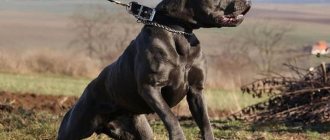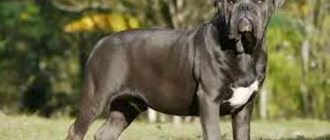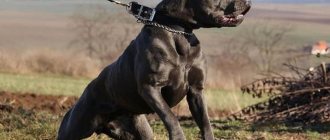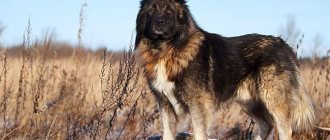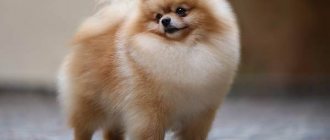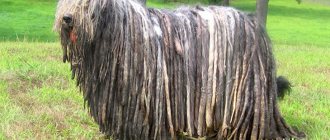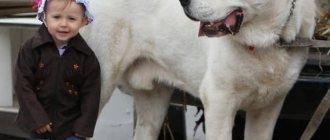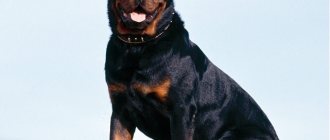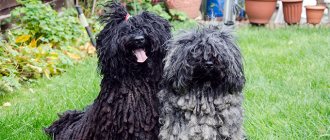Home » Interesting collections about cats and dogs
German dog breeds are perhaps the most popular. This is not surprising: among their common traits, the owners highlight an obedient and disciplined disposition, high intelligence, dignity and stature. In addition, the Germans worked on the service qualities of dogs. There are guards, hunters, and search pets... If you want to buy a dog of the German breed, check out the list: there will probably be one you like.
- 2 German boxer
- 3 German Jagdterrier
- 4 Drathaar
- 5 Kurzhaar
- 6 Great Dane
- 7 German Spitz
- 8 Rottweiler
- 9 Doberman
- 10 Leonberger
- 11 Weimaraner
- 12 Miniature Schnauzer
- 13 Miniature Pinscher
- 14 Reviews from dog owners
German Shepherd
This is a calm and loyal dog that was bred for search work and protection. Thanks to their classic physique, shepherds do not have any specific health problems. The disadvantages of the breed include the need for mental and physical stress.
The dog has short but thick hair, color - sable, zone, black, white
Care and maintenance
And although the German Shepherd can live even in spartan conditions, it still needs care. First of all, it is necessary to comb the hair from time to time (otherwise dead hair will be all over the house) and examine the dog once a week (after all, on walks you can pick up parasites, and examinations will allow you to respond to their appearance in a timely manner). You should bathe your pet only when necessary.
Feeding a German Shepherd
If you have a baby dog and have no experience caring for him, then first of all read the article on what to feed your puppy. From it you will learn what foods can be given to a month old, 2 month old, 3 month old, etc. for one-month-old puppies, also a feeding schedule and a list of prohibited foods.
We described how to feed an adult German Shepherd from natural food in a separate article (link below), and if you are interested in feeding a German Shepherd with food, read the next paragraph carefully.
Read in detail: what to feed your German Shepherd.
Dry food
Before choosing dry food for your pupil, be sure to find out what classes of dog food there are (follow the link to find a list of brands belonging to each class, as well as the pros and cons of each class).
For example, what is advertised on TV is usually poor economy food, while good ready-made food is super premium food and holistic food. If you want to choose the best dry food for your German Shepherd, take a look at these brands:
- Akana dog food - review of composition, reviews, price;
- Go dog food - reviews, composition overview, price;
- Bosch dog food (one of the inexpensive super-premiums);
- Find more food reviews in the Dog Food Reviews section.
Diseases and treatments
With proper feeding, representatives of this breed have good health, but they can get sick with something typical for dogs, as well as pick up parasites. How to remove worms from a German shepherd, how to get rid of fleas, what to do if a dog has diarrhea and many other instructions for treating diseases at home can be found in the “Veterinary” section.
German Shepherd training
Even if you have a dog as a pet, training a German Shepherd is a mandatory procedure. If you don't teach your puppy at least basic commands, you can end up with a big, unruly dog that can be a nightmare to walk.
Find out: how to teach your puppy the commands “sit”, “place”, “no” and other basic ones.
Video: training recommendations
German boxer
The Boxer is a balanced dog who is often assigned the role of nanny. However, it is important to understand that it is better not to leave any pet unattended with a child. Boxers are distinguished by loyalty and a high level of intelligence, but due to their short hair they often get cold. In addition, the flattened muzzle can cause problems with the eyes and heart.
Boxers are relatively small: their average weight is 20 kg
Doberman
- Height to shoulders: from 61 to 71 cm
- Weight: from 27 to 45.5 kg
- Life expectancy: 10 to 12 years
- Average cost: from 1000 to 2500 dollars
We have a German named Louis Dobermann to thank for creating this beautiful and noble dog. As a tax collector in 19th-century Germany , Dobermann did not count on people's hospitality while collecting taxes, so he created a dog that could protect him from aggressive taxpayers and their dogs. At some point in time, the extra “n” in the name of the breed was dropped.
Despite being considered a guard dog, the Doberman is actually affectionate and sweet with his family (though he usually only forms strong bonds with one family member).
German Jagdterrier
The Jagdterrier is an unpretentious hunting dog. He copes with the role of a companion with difficulty, but is well suited for those people who do not like intrusive animals. The Jagdterrier is independent and independent. However, these dogs can be aggressive, so they need regular training and discipline.
The dog is easy to care for and easily takes root in any conditions.
Leonberger
- Height to shoulders: from 64.8 to 80 cm
- Weight: from 40.8 to 77 kg
- Life expectancy: 7 years
- Average cost: from 1500 to 2000 dollars
If you're looking for a huge, fluffy dog to play with and cuddle with, look no further than the Leonberger. Of course, at first glance it could pass for a breed of dog similar to a bear or even a lion, but unlike these two wild animals, the Leonberger is not at all ferocious. These pets are extremely patient and affectionate with their family, and they easily make friends with people outside the family circle.
Kurzhaar
The Shorthaired Pointer is another breed that is good at guarding and hunting. The advantages of these dogs include their reserved character and loyalty to their owner. The shorthaired pointer is easy to train. It does not require careful care. However, representatives of this breed are absolutely not suitable for apartment living.
The body is athletic and slender, the color is dark, sometimes with a milky tint and inclusions
History of the origin of the breed
The Kurzhaar dog breed evolved over several centuries to its current form. Germany is considered its ancestral home, but the true genesis has not been established.
According to German scientists, the progenitors of the Kurzhaars are short-haired continental pointers who have lived in Germany for centuries. But there is plenty of evidence that such a statement is wrong. The first cops were brought to the German state only in the 15th century. Representatives of this group of dogs were successfully crossed with the local Hanoverian hounds, thanks to which they acquired a solid coffee color.
Bracchi Perdigero Burgos from Spain had no less influence on the origin of the breed. The skeleton of the animals was powerful, and the head was large. The dogs were constantly crossed, resulting in a new breed. Initially, the pets were called Old German Württenberg pointers, and later – Kurzhaar.
Everything about Kurzhaars can be learned from the stud book, the appearance of which dates back to mid-1872. The first dog entered into it was named Hector. He was heavy, his ears were long, and his head was large.
At the beginning of 1890, the blood of Pointers was “added” to the breed, which gave the animals an elegant appearance, increased their running speed and enhanced their sense of smell. The blood of these breeds was mixed for the second time in mid-1910.
German dog
The Great Dane is a record holder among dogs. The height of the pets reaches 110 cm at the withers, the average is 80–90 cm. These are very friendly dogs, but they are playful, and therefore can accidentally injure a person. It is better to keep them outside the city to ensure an optimal level of exercise.
It has a large size, color - fawn, merle, gray, black and blue
Dachshund
- Height to shoulders: from 12.7 to 15.3 cm (miniature), from 20.3 to 23 cm (standard)
- Weight: up to 5 kg (miniature), from 7.3 to 14.5 kg (standard)
- Life expectancy: 12 to 16 years
- Average cost: from 300 to 1000 dollars
More than 300 years ago, the dachshund was bred to hunt badgers. The German word for dachshund is “dachshund” (“dach” means “badger” and “hund” means “dog”). These dogs used their narrow, long noses to explore dens, and their sharp claws and powerful short legs helped them quickly dig through the ground.
Dachshunds come in two sizes: miniature and standard. Both are ideal for those looking for an apartment dog for small spaces.
Dachshunds are persistent and very intelligent pets; They never give up , whether they're waiting for a squirrel under the deck or stretching as far as they can to get a toy bunny from under the sofa. Be prepared for them to bark until they catch their discovered “prey.”
German Spitz
The Spitz is a small decorative dog that can charm anyone. However, it should be remembered that the fur of these pets must be carefully looked after. In addition, they are prone to obesity. But they are peaceful companions who love to spend time next to their owners.
The coat is thick and fluffy, color - white, gray, there is an undercoat
Kinds
Depending on the degree of hardness of the dog’s coat, the German Jagd Terrier is divided into 2 types:
- Wirehaired. The dog's fur is very dense, slightly prickly to the touch. Elongated, but short on the muzzle and tips of the paws. There are guard hairs on the muzzle that fold into “whiskers.”
- Smooth-haired. The fur along the entire length of the animal's body is short. The peculiarity is the shine of the coat.
These two types of representatives of the breed do not differ in character. The standard allows for a single color for them - sandy black. The front of the paws, sternum and neck are colored light, and the back, tail and head are dark. They also have tan marks. The presence of small spots on the dog’s chest or belly is not considered a deviation.
Miniature Schnauzer
The Schnauzer is considered one of the smallest working dogs: they weigh only 6–8 kg. Despite their size, dwarf schnauzers are very brave and loyal. They are active, so you need to deal with them, otherwise destruction in the house cannot be avoided.
The color can be silver, black, white, the coat is short, but thick and soft
Weimaraner
- Height to shoulders: from 58.4 to 68.6 cm
- Weight: from 25 to 40.8 kg
- Life expectancy: 10 to 13 years
- Average cost: from 700 to 1500 dollars
The Weimaraner, known as the "gray ghost" mainly due to its coloring, stealth hunting skills and speed, is not a couch potato. Well, at least until all of his physical exercises are completed for the day.
These are very active dogs, great for running and walking . They are so focused on human interaction that “me time” is a foreign concept to them. Several famous people, including Grace Kelly and President Dwight D. Eisenhower, helped popularize the Weimar Cop.
miniature pinscher
With proper training, the Pinscher will become a loyal, friendly and independent pet. However, under unfavorable circumstances, these dogs manipulate their owners and create chaos in the house, so they are not suitable for soft-tempered owners.
Gets along well with older children, but is not suitable company for an unintelligent child, as he can respond to careless actions towards himself with aggression
How to choose a puppy
Puppies of this breed are adopted after reaching the age of 1 month. During this period, babies begin to eat on their own.
When choosing a pet, pay attention to the following facts:
- Availability of a hereditary certificate.
- The baby should be calm, but at the same time energetic and demonstrate slight aggression. The dog is observed during play: when other dogs pester it in a calm state, it should initially not react in any way, and then it should fight back and instantly calm down.
- A healthy pet will never allow itself to be overcome during play.
- When feeding, the baby should quickly push away the weaker ones, making his way to the mother's nipples first.
- A German must have a confident bowel movement and a good appetite.
A mentally balanced Kurzhaar should not express fear at the sight of strangers, but on the contrary, try to get to know them better.
Similar breeds
| Drathaar | German Jagdterrier | Springer Spaniel |
